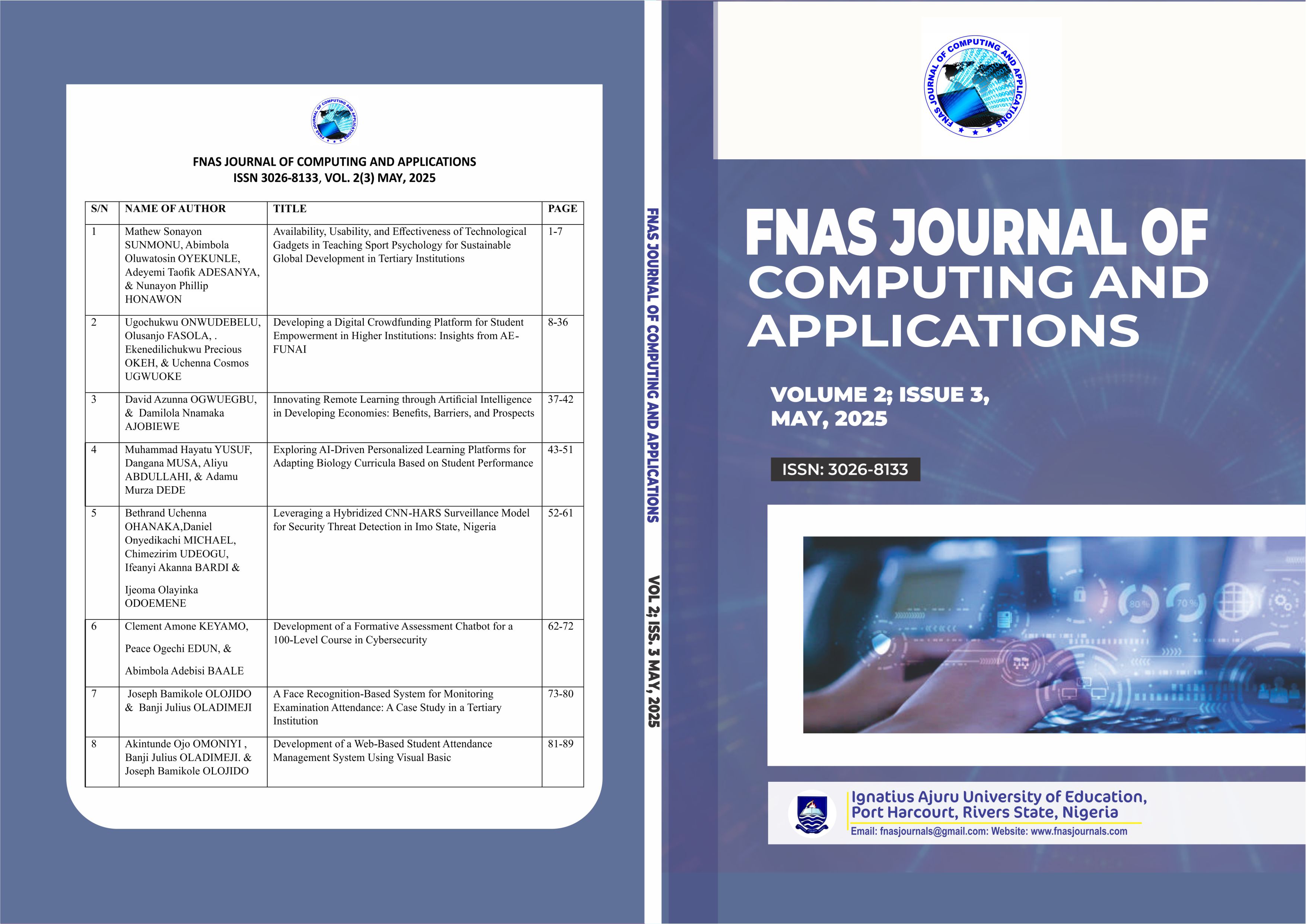Leveraging a Hybridized CNN-HARS Surveillance Model for Security Threat Detection in Imo State, Nigeria
DOI:
https://doi.org/10.63561/jca.v2i3.836Keywords:
Security surveillance, Convolutional Neural Network, Human Activity Recognition System, real-time detection, artificial intelligence, deep learning, crime preventionAbstract
The escalating security threats in Imo State, including terrorism, unknown gunmen attacks, kidnapping, one-chance drivers, and armed robbery, have created an urgent need for effective surveillance solutions. This study presents an integrated Convolutional Neural Network (CNN) and Human Activity Recognition System (HARS) model to enhance real-time security surveillance. Video feeds from strategically deployed CCTV cameras and drones are processed through a CNN for spatial feature extraction, identifying critical elements like edges, textures, and human shapes. Features indicative of suspicious behaviours, such as loitering or carrying weapons, are refined using Rectified Linear Unit (ReLU) activation functions and downsampled via pooling. Flattening and fully connected layers classify activities into normal (0.0–0.3), suspicious (0.4–0.6), or threat (0.7–1.0) categories. The HARS component complements CNN by performing temporal analysis, recognising activity patterns that may escalate into criminal behaviour. The system triggers real-time alerts for suspicious and threat activities, enabling rapid responses from security agencies. The model was evaluated on a 500-sample label dataset, achieving an accuracy of 84%, a precision of 86.96%, a recall of 80%, and an F1-score of 83.3%, demonstrating its capability to detect and classify security threats effectively. The findings highlight the transformative potential of advanced surveillance systems in improving public safety, aiding law enforcement, and restoring stability in Imo State. This innovative approach provides a robust tool for combating crime and enhancing security in both urban and remote areas.
References
Abimbola, A. (2024). Anxiety, fear of public buses… How a one-chance robbery affects commuters' mental health. Foundation for Investigative Journalism. https://fij.ng/article/anxiety-fear-of-public-buses-how-one-chance-robbery-affects-commuters-mental-health/
Achumba, I. C., Ighomereho, O. S., & Akpan-Robaro, M. O. M. (2013). Security challenges in Nigeria and the implications for business activities and sustainable development. Journal of Economics and Sustainable Development, 4(2), 79–99. DOI: https://doi.org/10.9774/GLEAF.8757.2013.se.00008
Adeleke, A. S., Angela, M., & Oliver, S. (2022). Organized crime in Nigeria: A threat assessment. United Nations Office on Drugs and Crime (UNODC) and National Institute for Security Studies (NISS).
Ali, S., Rahman, M., & Zhang, H. (2020). Real-time human activity recognition for enhanced surveillance systems using deep learning. International Journal of Advanced Computer Science and Applications, 11(5), 56–65.
Cheng, L., Wang, Y., & Liu, Z. (2019). Challenges and advancements in human activity recognition under real-world conditions. Computer Vision and Pattern Recognition Journal, 8(4), 421–435.
Chigozie, U. (2020). Imo State security network: Bridging the gap in local and federal crime prevention strategies. African Journal of Security Studies, 15(2), 112–124.
Glorot, X., Bordes, A., & Bengio, Y. (2011). Deep sparse rectifier neural networks. In Proceedings of the 14th International Conference on Artificial Intelligence and Statistics (Vol. 15, pp. 315–323).
Goodfellow, I., Bengio, Y., & Courville, A. (2016). Deep learning. MIT Press.
Kim, S., Park, Y., & Kim, J. (2019). Drone-based human activity recognition using deep learning for surveillance applications. Journal of Intelligent & Robotic Systems, 96(3–4), 401–414.
Kingma, D. P., & Ba, J. (2015). Adam: A method for stochastic optimization. In Proceedings of the International Conference on Learning Representations (ICLR).
Krizhevsky, A., Sutskever, I., & Hinton, G. E. (2012). ImageNet classification with deep convolutional neural networks. Advances in Neural Information Processing Systems, 25, 1097–1105.
Lara, O. D., & Labrador, M. A. (2013). A survey on human activity recognition using wearable sensors. IEEE Communications Surveys & Tutorials, 15(3), 1192–1209. DOI: https://doi.org/10.1109/SURV.2012.110112.00192
LeCun, Y., Bottou, L., Bengio, Y., & Haffner, P. (1998). Gradient-based learning applied to document recognition. Proceedings of the IEEE, 86(11), 2278–2324. DOI: https://doi.org/10.1109/5.726791
Liu, W., Anguelov, D., Erhan, D., Szegedy, C., Reed, S., Fu, C. Y., & Berg, A. C. (2016). SSD: Single Shot MultiBox Detector. In European Conference on Computer Vision (pp. 21–37). Springer DOI: https://doi.org/10.1007/978-3-319-46448-0_2
Niemann, T., Hoffmann, L., & Zhang, Y. (2018). Advances in deep learning for human activity recognition. Machine Learning Applications in Security, 19(2), 98–109.
Nwachukwu, I., Ugochukwu, M., & Ogbonna, E. (2022). The socio-economic impact of violent crimes in Imo State. Journal of African Studies, 13(4), 102–118.
Nwankwo, K., & Okafor, S. (2023). Armed robbery and its implications for security in Imo State: A policy perspective. Journal of Criminology and Public Policy, 28(3), 209–221.
Okafor, J., & Udo, C. (2021). Political tensions and security challenges in southeastern Nigeria. Africa Political Review, 9(3), 150–166.
Oketa, C. M. (2018). Socio-economic implication of kidnapping and hostage taking in southern Nigeria. South-East Journal of Public Relations, 1(1). DOI: https://doi.org/10.22259/2637-5893.0101008
Omenga, J. (2013). Section 14(2) of the 1999 Constitution of the FRN in the light of reason. NAJOPS, 9(2). Retrieved March 13, 2024, from
Opara, I., Nkem, E., & Adiele, U. (2022). Artificial intelligence in crime prevention: Applications and challenges. International Journal of Security Technology, 17(1), 56–71.
Otuu, O., Nwabuaku, W. K., & Ugwu, C. C. (2022). Efficacy of community policing and its funding for public security: A study of Imo vigilante groups in Imo State. International Journal of Scientific & Engineering Research, 13(6), 244.
Redmon, J., Divvala, S., Girshick, R., & Farhadi, A. (2016). You Only Look Once: Unified, real-time object detection. In Proceedings of the IEEE Conference on Computer Vision and Pattern Recognition (pp. 779–788). DOI: https://doi.org/10.1109/CVPR.2016.91
Ren, S., He, K., Girshick, R., & Sun, J. (2015). Faster R-CNN: Towards real-time object detection with region proposal networks. In Advances in Neural Information Processing Systems, 28, 91–99.
Srivastava, N., Hinton, G., Krizhevsky, A., Sutskever, I., & Salakhutdinov, R. (2014). Dropout: A simple way to prevent neural networks from overfitting. Journal of Machine Learning Research, 15, 1929–1958.
Wang, J., Chen, Y., Hao, S., Peng, X., & Hu, L. (2018). Deep learning for sensor-based activity recognition: A survey. Pattern Recognition Letters, 119, 3–11. DOI: https://doi.org/10.1016/j.patrec.2018.02.010
Zhang, Q., Li, W., & Yang, X. (2021). The role of deep learning in advancing human activity recognition systems. Journal of Applied Artificial Intelligence, 15(6), 67–83.
Zhu, X., Zhou, L., & Han, J. (2020). Facial recognition integration in surveillance systems: Enhancing security through AI. Journal of Computer Vision and Applications, 18(4), 321–340.








